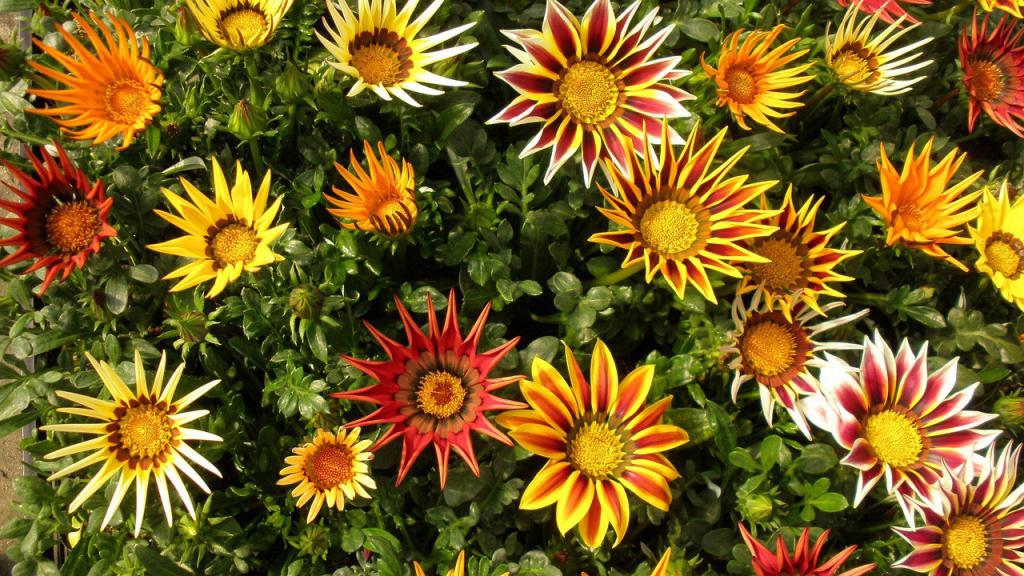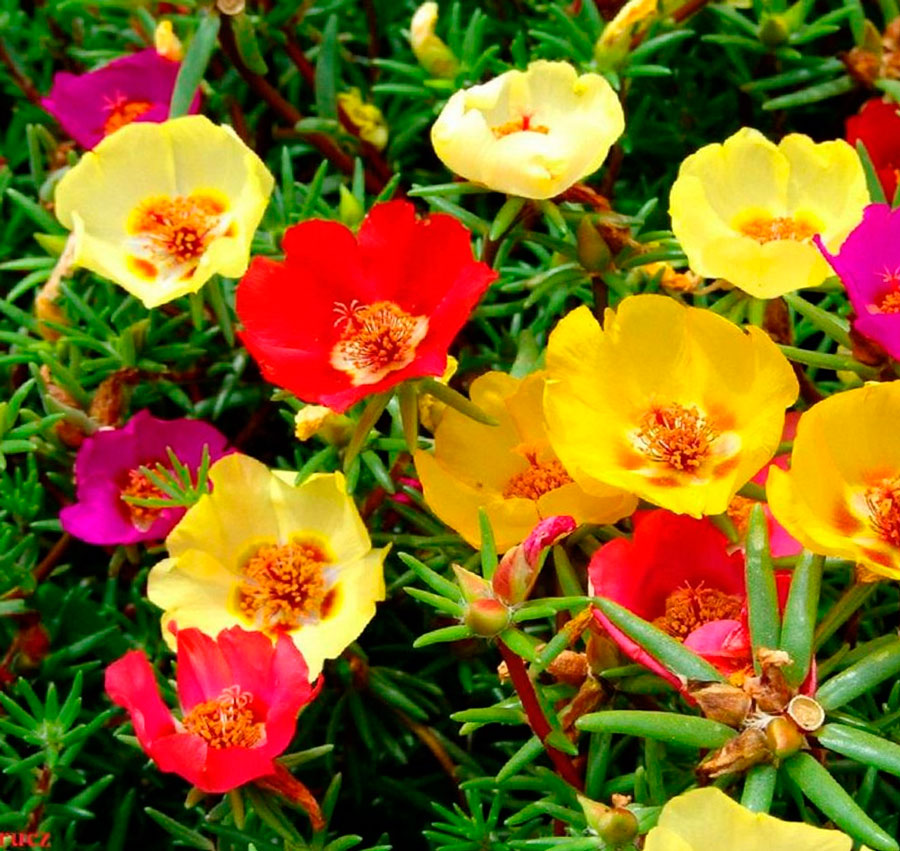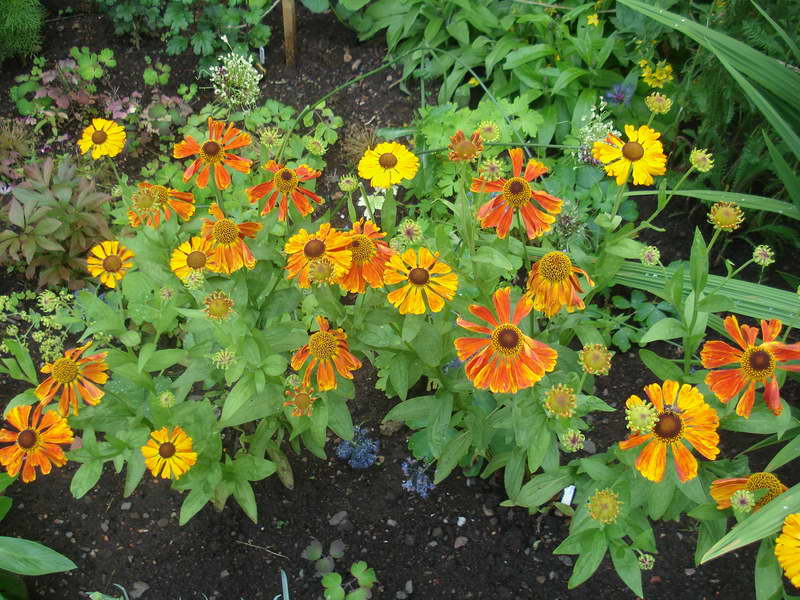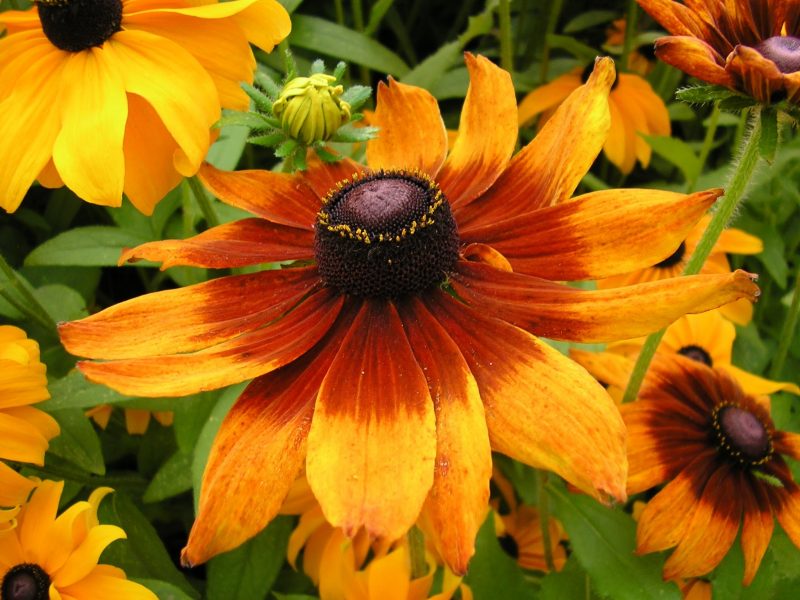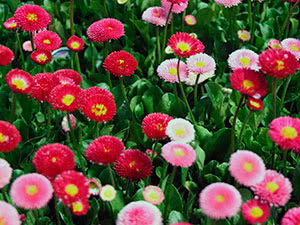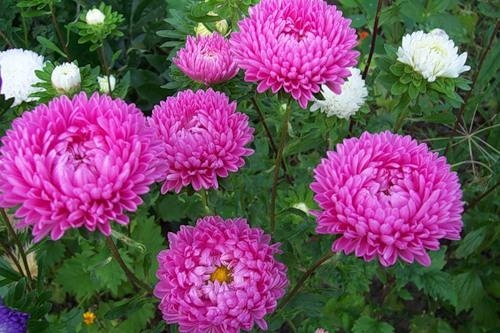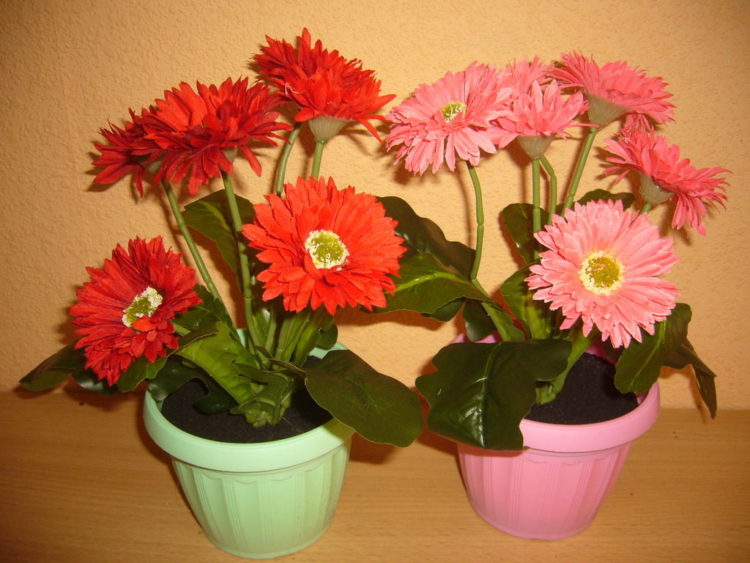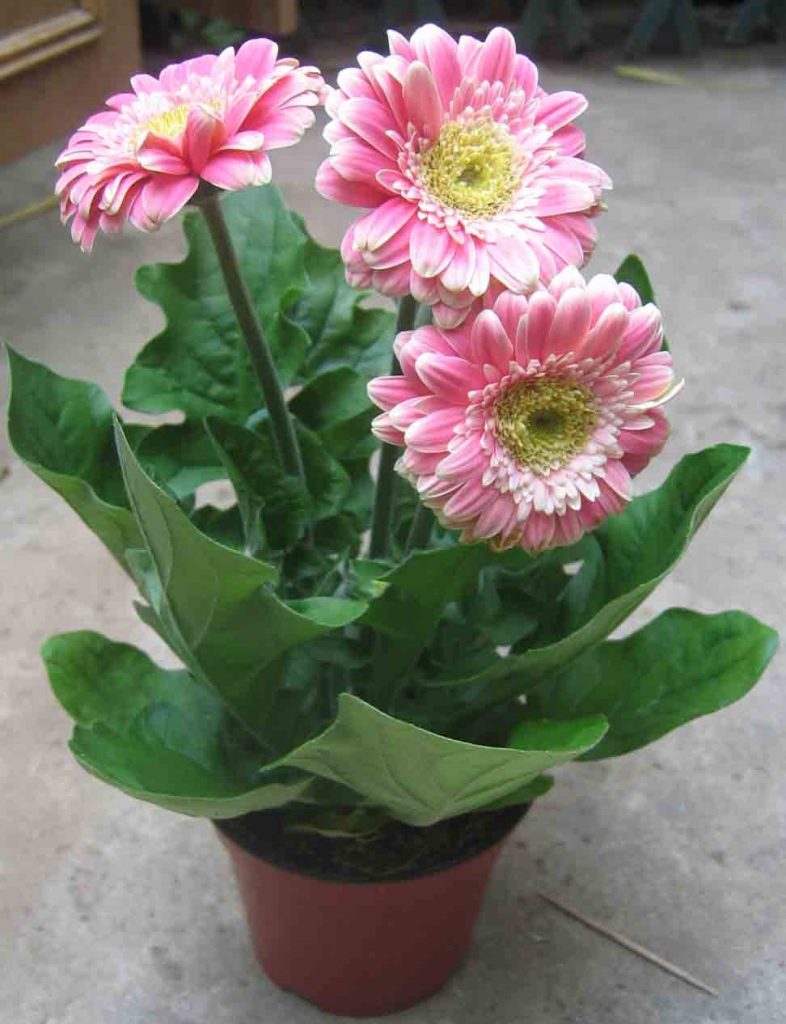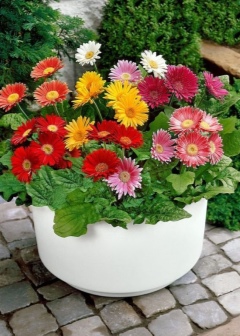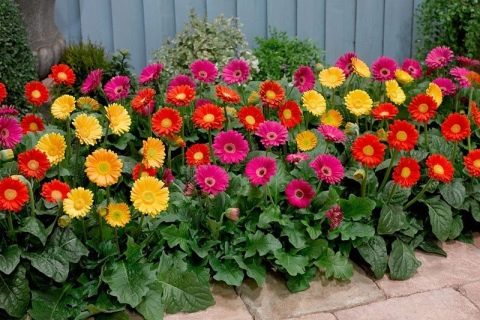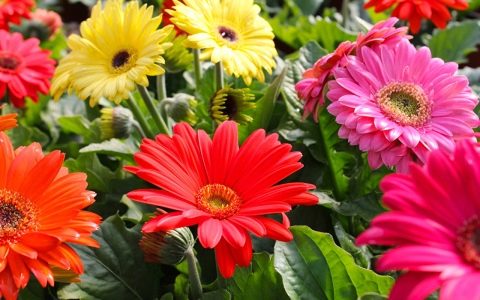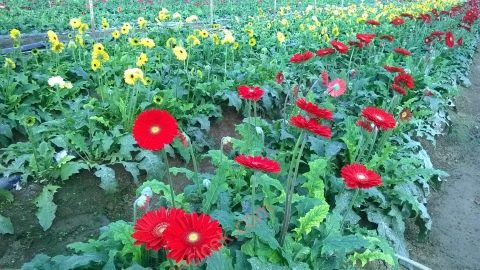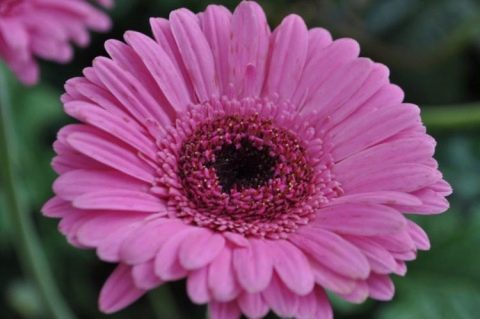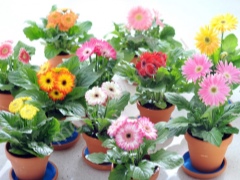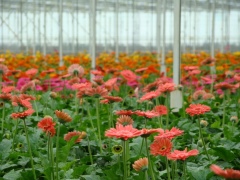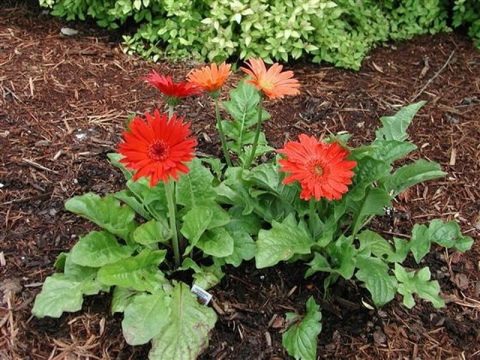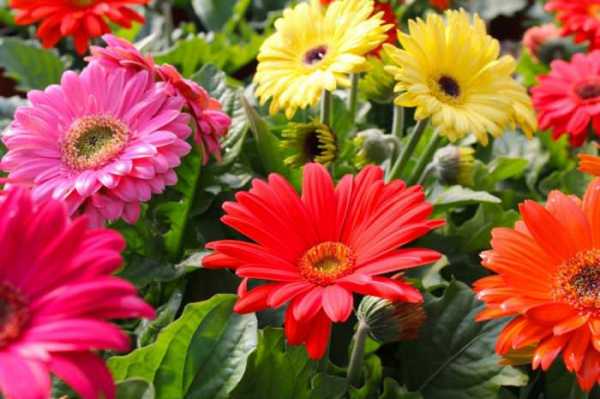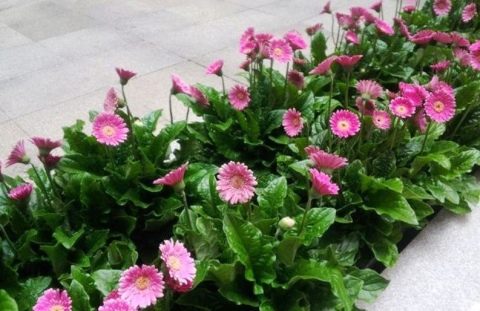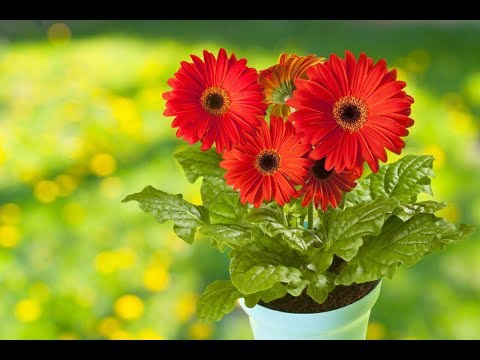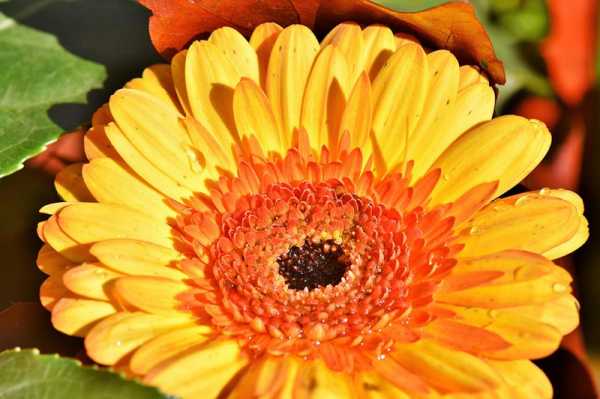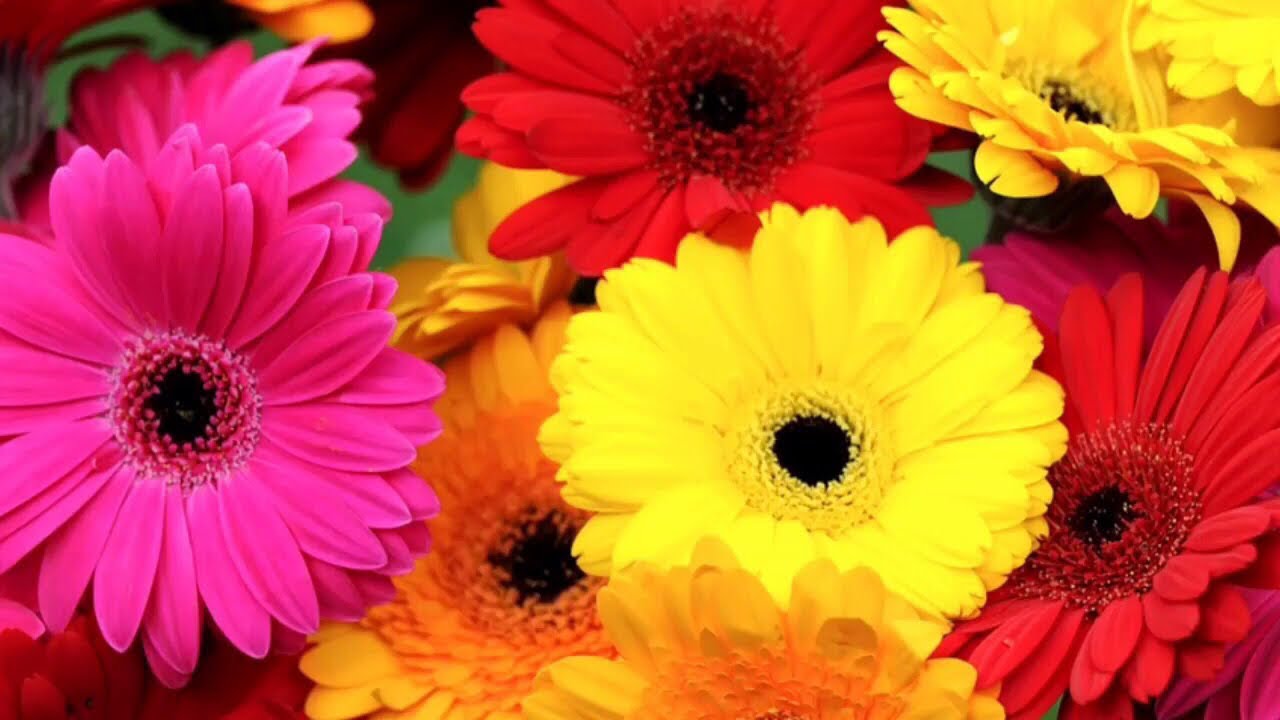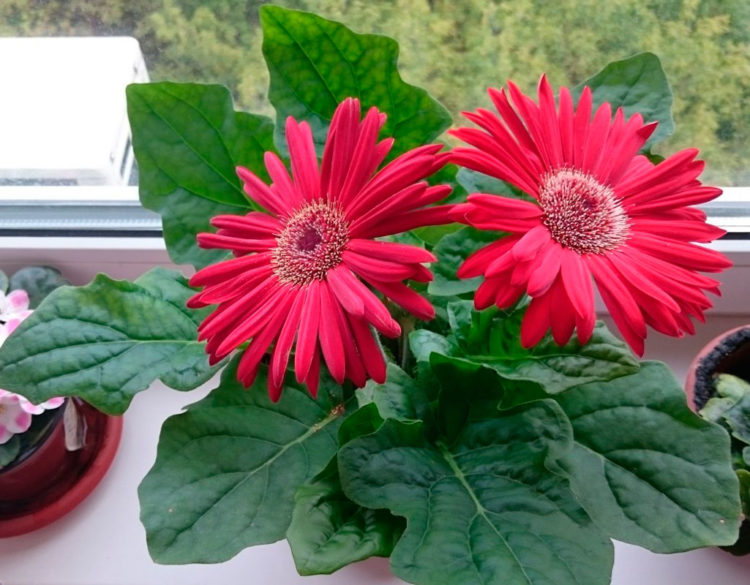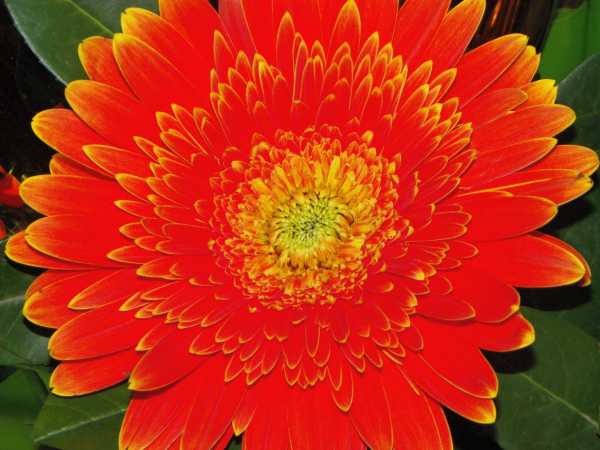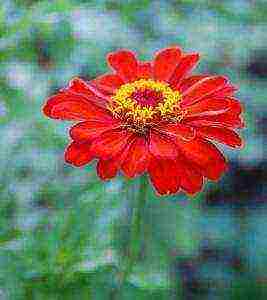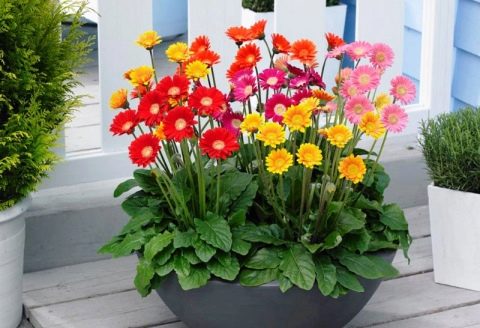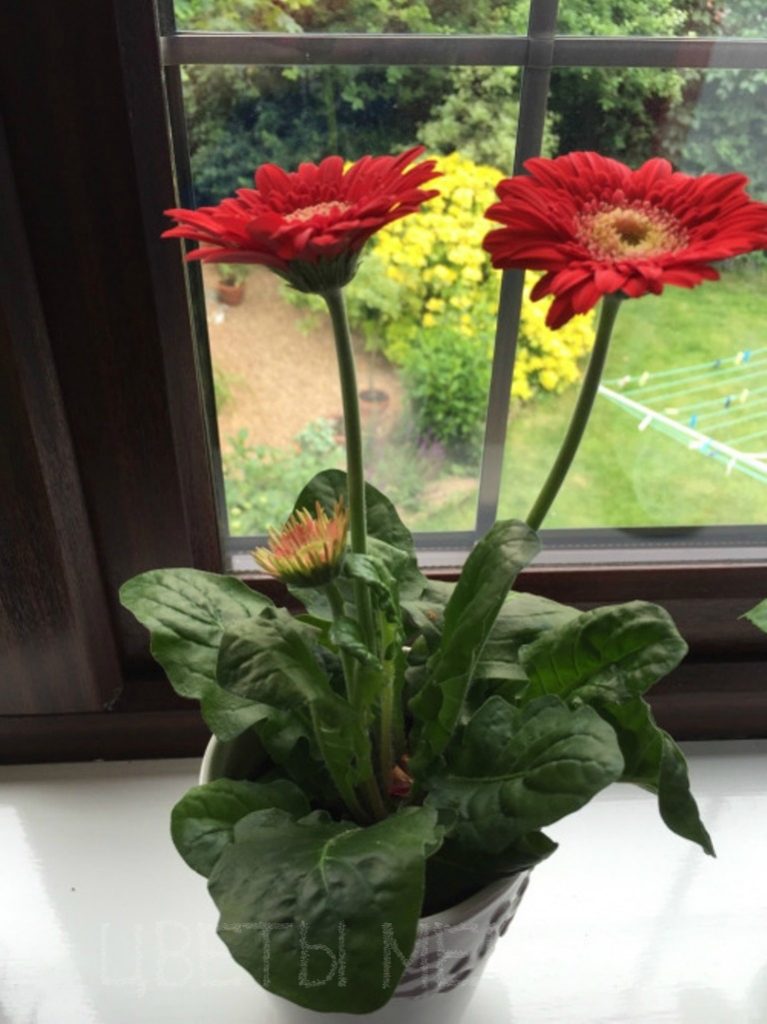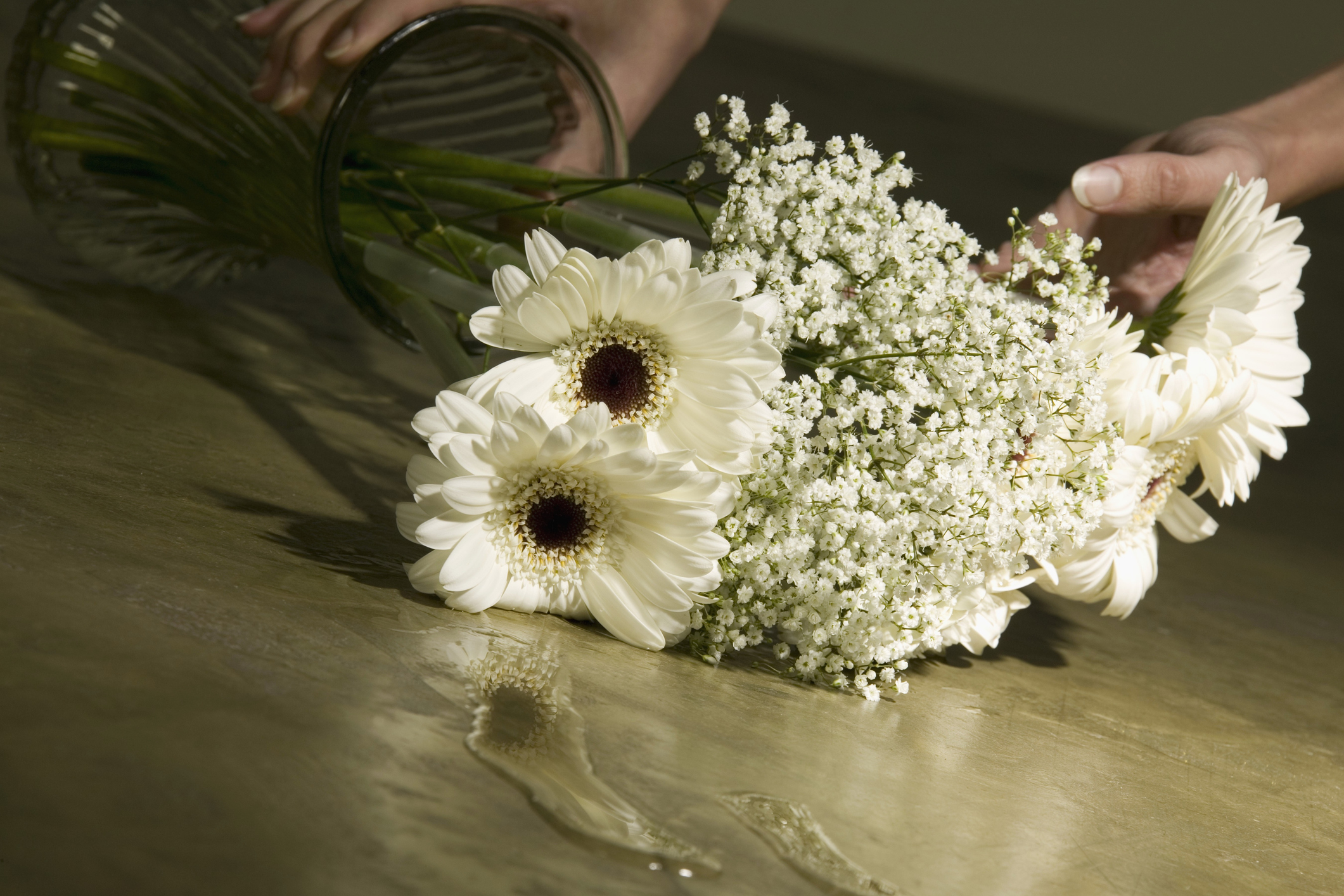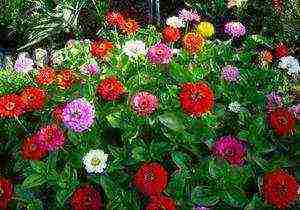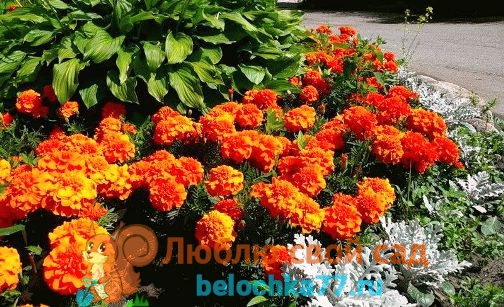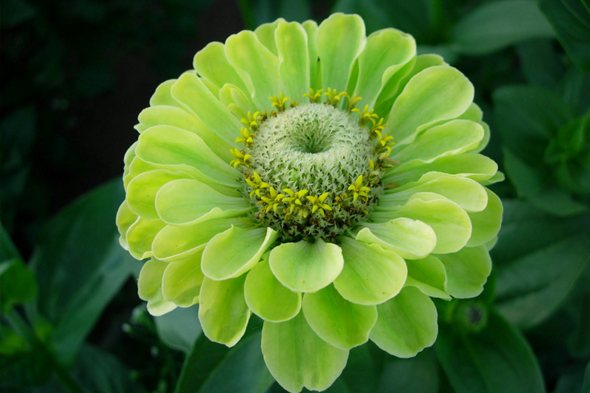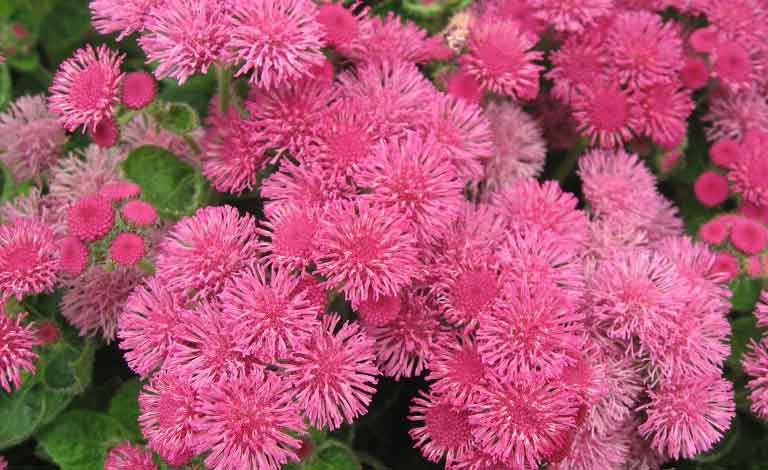Popular varieties of garden gerberas
There are not as many varieties of this flower as there are varieties, but they are the basis of choice for a gardener. Their description and characteristics make it possible to determine whether a plant is suitable for growing in certain conditions, and what features of agricultural technology it has. After all, gerberas in the garden, the cultivation and care of which require certain skills, can bring not only aesthetic pleasure, but also certain troubles.
Gerbera Jameson
This species is actively grown not only in the garden, but also indoors. Strong bush, feathery foliage, collected in a socket. The peduncle is not very high. Outwardly, the flower looks like a daisy.

Gerbera Jamson is suitable for growing in the garden and in the room
The diameter of the cap reaches 10 cm. The flowering period lasts 3 weeks. The colors are attractive and bright.
Hybrid species Garvinea Sweet Dreams
This type is one of the novelties presented to the attention of gardeners. The height of the bush reaches 0.45 m, its diameter is 0.4 m. Each gerbera simultaneously produces up to 20 peduncles.

Garden gerbera Garvinea Sweet Dreams blooms from spring to autumn
The color range is rich. The flowering period lasts from spring to autumn frosts.
Klondike
A large plant with a bush height and diameter of about 0.45 m. Each plant forms up to 50 peduncles per season. The variety of shades is huge.

Klondike is distinguished by its large bush size and abundant long flowering
The flowers are semi-double, their diameter reaches 12 cm. The flowering period lasts from July to October.
Abyssinian
The root rosette of this perennial consists of elliptical leaves. A characteristic feature is that young foliage is slightly pubescent.

Abyssinian gerbera has a delicate color scheme
Reed-type flowers, most often painted white, sometimes have reddish tints.
Gerbera orange
The rosette of the flower consists of elliptical leaves. Small bush, thick rhizome. Basket-type inflorescences are painted in the following colors:
- Orange;
- bright red;
- pink;
- dark scarlet;
- yellow.

Orange gerbera has a compact bush size and bright color of flowers
The middle flowers are sometimes black or dark purple.
Gerbera Wright
The rosette in this species consists of pinnate or lobed leaves. The peduncle is long, at the end of it a flower is formed that looks like a large chamomile. The middle of it is painted yellow or white. The color of the petals can be:

Gerbera Wright is characterized by a rich range of colors
- red;
- orange;
- purple;
- yellow;
- pink.
Gerbera Vega
This species was bred by American breeders. It differs from other varieties in large inflorescences, which reach 13 cm in diameter, and narrow long petals.

The Vega hybrid has a very large flower size
The length of the peduncle is about 0.7 m. The color of the flowers is yellow-orange.
Short description
Gerbera is a herbaceous perennial from the Astrov family. Since the plant came from a warm climatic zone, it is quite capricious. Growing a flower on your own plot requires a certain amount of knowledge. In the literature, you can find other plant names, for example, transvaal daisy or chamomile.

Transvaal chamomile will become a real decoration of any backyard territory
The botanical description of the garden gerbera is as follows:
- It is a bush with a height of 30-35 cm.Some species can grow up to 50 cm.
- The root system is fibrous, the roots are short.
- The leaves are located in a basal rosette, elongated, ending in a kind of "peaks", fleshy. The color is deep green.
- The flower is shaped like a chamomile. There are simple, double and semi-double gerberas. Diameter - from 10 cm. The color of the petals can be white, pink, yellow or red. The core is always brown.
- The fruit is a compact capsule.
Note! The discoverer of gerbera in wild Africa was the Germanic explorer Traugott Gerber, who gave the plant his name. The duration of flowering is from a month to three, but elegant inflorescences will delight the eye of the grower only with proper care
This is the garden gerbera: planting and caring for this plant is considered quite difficult, therefore it is not recommended for beginners
The duration of flowering is from a month to three, but elegant inflorescences will delight the eye of a grower only with proper care. This is the garden gerbera: planting and caring for this plant is considered quite difficult, so it is not recommended for beginners.
Species diversity
The number of species of garden gerbera is large - more than 50. And thanks to the efforts of breeders, new hybrids regularly appear with improved properties and increased decorative effect. However, there are only two “progenitors” of the main garden hybrids - Jameson's gerbera and green-leaved.
Here are some varieties of street gerbera (Gerbera) popular among flower growers:
- Jamson. Perennial, resistant to the vagaries of the weather in the middle zone. Differs in decorativeness, variety of color options. Inflorescence up to 10 cm in diameter.
- Patio Klondike. The height of the bush is up to 0.5 meters, the leaves reach a length of 15 cm, the flowers are white or scarlet.
- Wright. A very capricious variety, suitable for growing in a greenhouse. However, the stunningly beautiful lush bloom redeems all the worries associated with care.
- Abyssinian. The bush is up to 45 cm high, the flowering period is from the beginning of summer to the first frost. The flowers are white or crimson.
- Vega. This is a hybrid of American origin with large flowers up to 14 cm in diameter and elegant, sunny orange petals.
- Alcor. The most suitable variety for outdoor cultivation with deep pink flowers and narrow leaves. The height of the shrub does not exceed 60 cm.
The breeders also managed to develop several mini-varieties that are ideal for decorating compact flower beds and rockeries. These are Royal Lemon, Orange, Scarlett and others. Also, flower growers often plant special varieties for home conditions.
Growing features
To grow a beautiful, strong plant from a seed that will delight you with friendly flowering, you need to know the nuances of planting and subsequent care... What to avoid when growing Gerberas in pots, we talked about in this material.
Sowing dates
You can sow seeds at any time, starting from the moment you collect the seed. But, in order not to contradict the nature and biorhythms of the plant, make a spring planting beam. Preparation for growing: soil and seeds.
Soil preparation
Gerberas love porous and light soil, which is prepared from 2 parts of leaf humus, 2 parts of peat and 1 part of river, washed sand. In this case, the soil should be neutral or slightly acidic. Before planting, the soil is disinfected by spilling with a solution of potassium permanganate, the temperature of which is +50 degrees. To prepare the seeds, you do not need to do anything, sowing is carried out without soaking, and they do not need processing.
Landing rules
The flower seeds are very small, and they do not need to be deeply deepened into the soil, it is enough just to scatter them over the surface and sprinkle with peat. The soil must be moist. For rapid germination, it is worth providing the planting material with certain conditions, creating a greenhouse effect.
For this, the container is covered with glass or film. The first shoots will appear in a week, but every day you need to remove the covering material for ventilation.As soon as the seeds germinate, the glass is removed.
The optimum temperature for germination is +20 degrees. Gerberas can be sown in a small container, or in separate peat pots, this will be much preferable, since the subsequent transplantation into a pot will not damage the root system.
Watch a video about planting Gerbera seeds:
Pot selection
As soon as 3 true leaves appear on Gerbera seedlings, it can be transplanted into a separate pot. The pot is not taken large - if the plant has too much space, then it may not bloom.
The seedling is placed in a 700 ml clay pot. A large layer of drainage must be laid at the bottom of the planter.
Tip: Although Gerbera will grow well in a clay container, transplanting it into a plastic pot is much preferable, since you can water the plant in a pan.
Reproduction methods
New copies of gerberas can be obtained in 3 ways:
- Seeds. We will talk about this in more detail below. A flower grown in this way will bloom for the first time only after almost a year. For cultivation, you can use seeds collected with your own hands.
- Cuttings. Cuttings are used to preserve the characteristics of hybrid varieties when seed propagation is not suitable. To do this, cut off a part of the stem with a knot and a leaf, and then root it in the ground.
- By dividing the rhizome. To do this, take out an adult plant from the ground and divide the roots. This method, as well as cuttings, helps to obtain a varietal plant similar in characteristics.
Read in detail about all methods of gerbera reproduction in our material.
Gerbera seeds are elongated with a fluffy tassel at the end. The size is small, one gram contains from 300 to 500 pieces.
Pollination of an indoor flower
Gerbera is not a self-pollinated plant, as its reproductive organs ripen at different times. Therefore, to obtain seeds, artificial cross-pollination is required during the flowering period.
Ripe pollen can be used within 100 days. You can store it in a clean, dry glass container with a lid. Both plants must be of the same species to maintain a variety. If this is not possible, you can use what is available.
In this case, the result is unpredictable, the resulting seeds can give a completely different plant in terms of characteristics. For home pollination, ripe pollen from one flower is transferred to another flower.
You can simply collect the pollen with a brush and "smear" the middle of another flower. It is better to do this several times during flowering, to be sure. Ripe pollen can be seen by the protrusion of the middle of the flower with yellowing.
When do they ripen?
The gerbera seed ripens 3-4 weeks after successful pollination. Accordingly, this happens in the fall, at the end of flowering (you can find out about when and how much gerberas bloom and why they do not do this).
How to collect?
Once the middle of the flower becomes fluffy like a dandelion, you can collect the seeds by carefully disassembling the flower with your hands. Gerbera seeds quickly lose their germination, so they need to be planted within 6 months after harvest.
How much are?
Having looked through a bunch of offers on the Internet for the sale of seeds, I can voice the approximate price range for gerbera seeds from 22 to 89 rubles per package, which contains 10-25 seeds. Varieties: Jameson's gerbera, Festival, Rayons, California Giant. The seeds are mostly in the form of mixtures, that is, what color palette you get is unknown.
Below you can see photos of the gerbera and its seeds.
Gerbera outdoors
Gerbera is one of the most popular flowers for open ground, capable of decorating a nondescript garden corner, flower garden, public park. But it is worth considering the African roots of the plant.The summer months in central Russia are quite satisfied with an elegant flower, but on condition that there are no differences in day and night temperatures. But the cold autumn and frosty winter are not at all the conditions under which the gerbera is able to overwinter. If the flower is not dug up in time, it will turn into an annual, that is, it will simply die and next spring you will have to plant a new plant.
Therefore, in general, the climate of central Russia is not intended for year-round cultivation of African beauty in the open field. In such climatic conditions, the flower is best grown in greenhouses or mobile pots.
But residents of warm regions are more fortunate. Mild winters are suitable for a dormant period outdoors, but covering the root system with a pile of fallen leaves or straw is a prerequisite for the survival of the flower. It is with this kind of care that the gerbera can grow for more than one year.
Gerbera blooms all summer. Bright colors are pleasing to the eye for 3-4 months. But this period can be different, it all depends on the characteristics of the variety or hybrid. If you want to collect a bouquet of these bright flowers, then the peduncle will have to be broken out or carefully twisted out of the leaf outlet, being careful not to damage it. If even a small piece of the stem remains after pruning, the plant may rot and die.
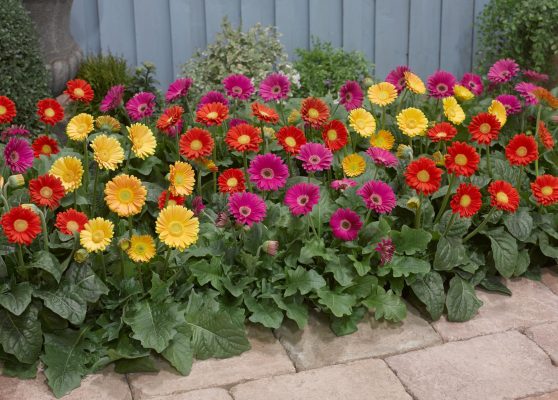
Bright elegant gerberas feel great in warm regions and can even hibernate outside.
Growing conditions
- In winter, the gerbera feels great at a temperature of 6 - 8 ° C. As already noted, in the southern regions, the plant is able to survive the winter months with an average temperature of 0 to –3 ° C, being in open ground under a reliable shelter.
- Despite the love for a lot of sunlight, the flower needs to be slightly shaded during the hottest midday hours. At this time, the leaves may wilt slightly. But with the arrival of the evening coolness, the turgor in them is restored.
- It is not necessary to spray the gerbera specially. The fact is that moisture trapped in a leaf outlet can cause a decay process that can destroy the entire plant.
What is the difference between indoor and outdoor varieties
In the open field, strong plants with a high peduncle and large inflorescences are grown. They are more hardy and resistant to diseases and pests.
In indoor floriculture, preference is given to undersized compact hybrids with short peduncles and small flowers. These plants are more pampered and demanding on living conditions and care.
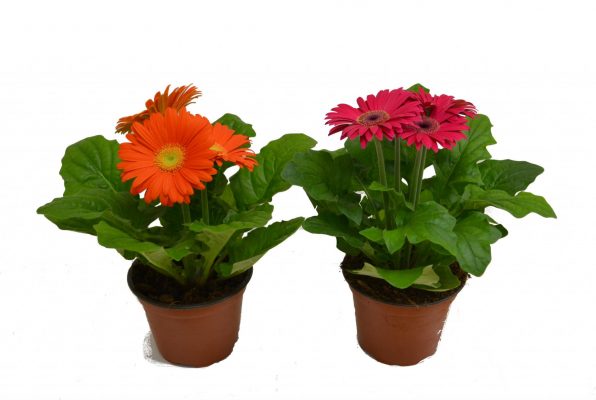
Unlike outdoor gerbera, indoor varieties are compact.
Types and varieties
Gerberas are found in the entire color palette, they are decorative and durable. For several decades, these plants have been among the most popular flowers. As already noted, previously it was possible for them to reproduce only in greenhouses, since they required greenhouse conditions (the plant originates from hot regions of the world), and high stems needed to be protected from wind and drafts. But since dwarf varieties have also been created, they are grown in pots or directly in the open field. Gerberas are usually classified into two main groups, which have been bred respectively from the two main South African species:
green-leaved gerbera;
Gerberas are usually considered annuals. But if the indoor varieties after flowering and wilting are left for one month without watering, and then resumed irrigation and fertilizing, the gerbera will again release the stem, leaves and bloom. Although potted mini-gerberas do not have such large flowers (2-4 cm in diameter) as their congeners from the greenhouse, this does not mean that they are less attractive and adorable. Moreover, we can choose from a number of extremely beautiful varieties of flowers of different colors, including white, pink, cream, burgundy, red, blue, light blue, purple, yellow, mix,as well as with different inflorescences: single, double, full, needle, hybrid.
Gerbera Jameson is an ideal, albeit slightly forgotten, plant. After cutting, its flowers last up to 14 days. Gerbera has inflorescences, typical for Astera, - baskets. It is a perennial plant that produces numerous random roots growing at the base or side of the shoot. The leaves are lobed, densely pubescent below. Flowers - typical of the Asteraceae family - are collected in a basket-type inflorescence. The petals are long and slightly bent, forming one or more curls. The color is very diverse, but pastel colors prevail.
Gerbera garden: planting and care
The soil for planting should be slightly acidic (acidity - 4.5-5.5 pH). More acidic soil will delay the development of the root system. For an adult flower, a clay pot with a volume of 1-2 liters is suitable. To improve the quality, crushed pine bark or expanded clay is added to the soil. It is recommended to constantly loosen the top layer so that air can penetrate to the roots.
When transplanting from a small pot to a large flower, it will take a long time to get used to the new conditions. The transplant is best done in the spring. It is necessary to transplant the plant together with a lump of earth, so it will begin to grow faster. A flower bought in a store should not be transplanted immediately, it needs time to acclimatize.
Gerbera is a light-loving plant. She may even be in direct sunlight for some time, so she will be comfortable on the windowsill of a window facing west or east. In autumn and winter, it needs additional lighting, for which fluorescent lamps should be used. The abundance of sunlight can lead to a loss of brightness in the leaves, so the flower should be protected from the sun at noon. In case of excessive or insufficient illumination, flowering may not occur. In low light and poor nutrition, the flowers will be pale and ugly.
Gerberas love warmth. Large differences in day and night temperatures negatively affect the development of inflorescences. In spring and summer, the optimal temperature will be 22-24 ° C (at least 20 ° C). Flowers love fresh air. Therefore, the room should be regularly ventilated. In summer, the flower should be taken out into the garden or on the balcony.
Gerberas like frequent, but not plentiful watering during growth. Overflows should be avoided. The water in the pot must not stagnate. The rosette of the root leaves must remain dry. It is good for watering to use a tray filled with moss, sand or expanded clay gravel. Once every 2 weeks, the plant is fed with mineral fertilizer. It is impossible to use organic fertilizers, as they contribute to rotting of the root collar. Faded buds must be removed immediately so that they do not interfere with the development of new peduncles.
In winter, when the flowering period ends, the gerbera needs a temperature of about 15 ° C, but not lower than 12 ° C. Watering should be limited. The soil should dry out a little between waterings. Top dressing is not needed in winter.
How to care for a perennial
Despite the relative unpretentiousness, growing gerberas has its own subtleties that any grower needs to know.
Watering rules and humidity
Watering should be done in small portions, but often. During the period of active development, they water abundantly, after flowering more than moderately, keeping an eye on the moisture at the roots.
Watering is necessary, observing the following rules:
- stagnation of water should not be allowed;
- water must not be allowed to enter the rosette of leaves and leaf plate;
- use of warm water: in winter - 16-20 ° С, in summer - 26-27 ° С;
- 1 m² of flower garden consumes 25 liters of water.
Top dressing and soil quality
Once within 2 weeks from March to the beginning of autumn, the plants must be fed, preferably with mineral fertilizers. The best option for gerbera is a complex mixture for flowering crops.
For your information! A perennial reacts well to magnesium sulfate, and the lack of illumination can be compensated for with a phosphorus-containing fertilizer.
The preferred soil for gerberas is nutritious, well-drained and low in acidity. In gardening stores, you can buy specialized soil for gerberas or roses, but you can make a soil mixture for a flower garden yourself. To do this, mix in equal proportions deciduous turf, peat and drainage (sand or perlite).
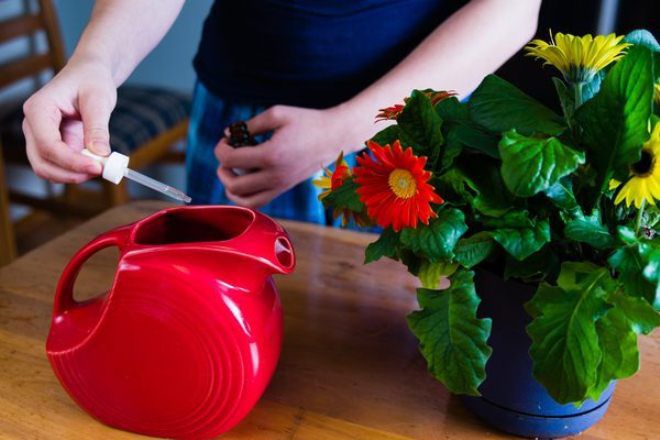
Fertilization is required throughout the season
Pruning and replanting
It is produced after flowering begins. It is necessary to carry out sanitary cleaning by removing dry leaves and stems directly. It is recommended to cut the extra leaves in the outlet, this technique stimulates the appearance of new flowers.
Repotting is a great way to rejuvenate a mature plant. At the time of transplantation, an adult bush can be divided into several small
For this, the rhizome of the dug plant is cleaned of soil, carefully divided with a disinfected blade or a sharp knife into 2 parts. The cut is treated with powdered charcoal or ash and, until it begins to dry out, the seedlings are planted in a new place and watered abundantly
Winter gerbera care
A perennial plant grown from seeds and planted with seedlings in open ground can delight with its flowering for several years. When grown in regions with not very cold winters, you need to prune dried stems at a level of 10 cm from the soil, and cover the bush with straw or dry leaves. However, it is worth monitoring the temperature, since in warm weather, the bush is likely to undergo podoprevanie.
In regions with cold winters, home gerbera bushes are recommended to be dug up for the winter and transplanted into pots for wintering in a warm, bright room with good ventilation. The air temperature in it should be 6-10 ° C.
Important! Flowers need to be dug out with a clod of earth so as not to injure the roots
How to grow?
It is quite simple to grow a gerbera from seeds at home, it is enough to create the necessary conditions for it, observe the temperature, climatic regime, and do not forget to feed. This is a rather unpretentious plant, it does not require complicated care, it sprouts easily, and blooms beautifully. Even a novice florist can handle it.
Top dressing
You need to feed the gerbera at a time when it is gaining green mass, and during the flowering period. No fertilization is required during the dormant period.
Mineral compounds are best suited for feeding gerberas. At different periods of the life of a flower, these must be different substances.
So, when gaining green mass, the plant needs a complex fertilizer, which includes nitrogen. This element contributes to the correct formation of leaves, the full development of the plant.
When the gerbera begins to bloom, you need to change the type of feeding. During this period, it is better to apply potash fertilizers. Potassium accelerates metabolic processes in cells, helps the plant to endure drought more easily, accelerates photosynthesis, the plant adapts more easily to low temperatures.

Watering
Gerbera does not like abundant watering, but it also does not tolerate dry soil well. It is necessary to observe the "golden mean" and ensure that the soil is always moderately moist.
The best option would be a pallet. Then the plant itself will be able to take enough water when it needs it. It is also necessary to monitor the temperature of the water. It should be roomy, not very cold and not hot.
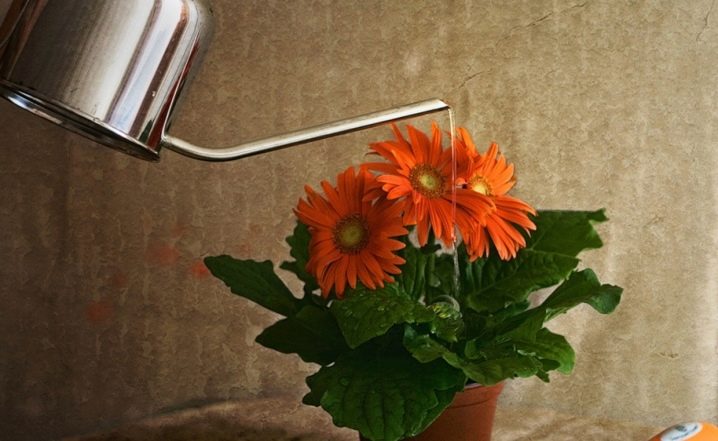
Climatic conditions
For gerbera, temperature and humidity levels are important. She is comfortable feels with temperature of +18.22 degrees, at higher or lower values it may start to hurt, wither, may stop blooming
In the cold season, when the plant is at rest, it needs to provide a temperature from +16 to +14 degrees, it can be slightly lower, but not less than +12.
As for humidity, there are also some nuances that must be observed. First of all, you need to remember that you should not spray gerbera from a spray bottle, it is better to spray water near the plant, without getting on the leaves. Another option is to place a container filled with water near the plant pot. The moisture will gradually evaporate and the flower will receive the moisture it needs.

Diseases and pests
If all the necessary conditions are met, gerbera is not prone to disease. But in case of violation of the temperature regime, improper watering or spraying, the plant may begin to rot, or powdery mildew will appear. It is easy to understand that something is wrong with the flower - its leaves will turn yellow or become covered with spots.
Powdery mildew is a white patch on the leaves that you can simply wipe off with your bare hands. If specks are visible on dying leaves, they are removed.
A remedy such as "Fitosporin" will help well in the fight against the disease - they are sprayed with a plant.
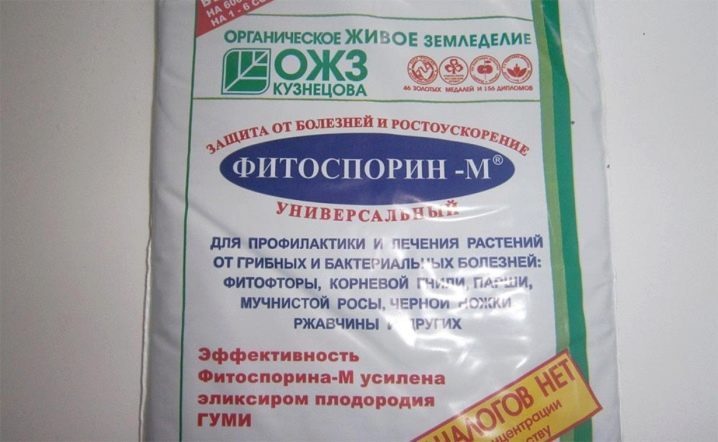
Gerbera pests include aphids, whiteflies, scale insects and mites. Methods of dealing with them are usual - you need to disinfect the soil, carefully examine the gerbera, remove unhealthy or damaged parts in time, and follow the rules of care.
Aphids can be fought with anabasine sulfate, nicotine sulfate, or the like.
To get rid of a spider mite, you need to wipe the leaves of the plant with soapy water (but then it must be washed off) or with an insecticide. After a week, repeat the treatment.
Whitefly is afraid of drugs that contain permethrin. The plant is sprayed with these compounds every 3 days until the pests disappear.
And you also need to know how and when to transplant a gerbera. Throughout the life of a plant, this should be done no more than 2-3 times. Each next container should be a couple of centimeters larger in diameter than the previous one, so that you can freely place the roots and pour fresh soil around them.


